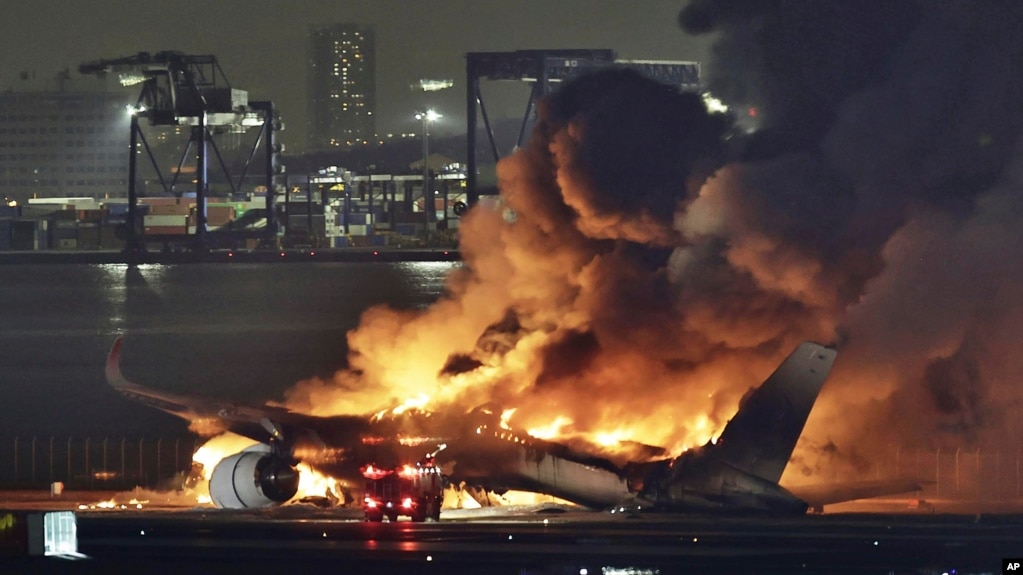AUDIO
Plane Crash in Tokyo Raises Design Concerns

Investigators are studying what went wrong when a Japanese coast guard aircraft and a passenger jet crashed into each other on Tuesday at Haneda Airport in Tokyo.
Officials want to find out what caused the crash. But there are also many questions about the fire that broke out when the planes collided on the runway.
The body of the passenger jet, an Airbus 350, was made of carbon-composite fibers. Passenger aircraft bodies have traditionally been made of aluminum.
The crash may become an important test of the safety of composite materials for some uses in aircraft.
The crash
Communications from air traffic control at the airport describe some of the events leading to the crash. The larger Japan Airlines (JAL) passenger jet was given permission to use the runway where the coast guard plane, a Bombardier Dash-8, was preparing for takeoff.
When they struck each other, an orange fireball exploded from the aircraft and the passenger jet continued down the runway covered in flames.
When the plane stopped, crew members and all 379 passengers slid down emergency chutes within 20 minutes. All survived. The captain of the coast guard plane got out, but five members of the crew died in the crash.
Safety experts are praising the airline’s crew and the passengers for escaping the burning plane. The crew shouted, warning the passengers to run away from the plane.
The composite material
Composite materials have been used for many years inside commercial aircraft. But the first commercial plane to have its body, or fuselage, and wings reinforced with carbon fibers was the Boeing 787. It went into service in 2011. About 1,100 of the planes have been produced.

This aerial photo show the burn-out Japan Airlines plane at Haneda airport on Wednesday, Jan. 3, 2024, in Tokyo, Japan. (Kyodo News via AP)
The Airbus A350 followed in 2018. About 570 have been sold.
Aircraft designers use composite materials because they strengthen plastics and other materials. Boeing says the material can save 20 percent of the weight of aluminum. The reduced weight saves fuel.
Boeing and the Federal Aviation Administration (FAA) tested the strength of composites to get certification for the 787 jet. But concerns remain about gases released from such materials when they burn.
John Goglia is a former member of the National Transportation Safety Board, which investigates aircraft accidents. He said, “There has always been a concern about composites if they catch fire.” Goglia noted that the gases released when composites burn are dangerous. They can even be dangerous after the fire is put out because the fibers might remain in the air.
The FAA has said for more than 20 years that there are dangers related to composite materials. FAA officials say the main health dangers include sharp pieces of material, dust and poisonous gases caused by burning substances that hold the material together.
Did it make a difference?
Although the inside of the passenger plane filled with smoke after the explosion, all 379 passengers were able to escape.
John Cox, a safety expert, noted: “That fuselage protected them from a really horrific fire — it did not burn through for some period of time and let everybody get out.”
Goglia said there is no real evidence whether composite materials or aluminum are better at resisting fire long enough to protect people.
However, one passenger on the JAL flight said the smoke “stung” very much.
Todd Curtis, a safety expert and former Boeing engineer, warned that injuries from dangerous smoke could take a long time to show up. Passengers involved in accidents usually are in shock and often do not recognize their injuries.
Another concern, experts noted, was the amount of time it took firefighters to put out the fire. Pictures show the JAL flight’s burned wreckage near one of the runways. The body was almost completely destroyed by fire.
In 2013, a fire at London’s Heathrow Airport involving an Ethiopian Airlines Boeing 787 was difficult to stop. Safety expert Curtis said, “putting out the fire took much more effort that a typical airliner fire.” Curtis said he worried at the time about composite fuselage fires.
Those concerns, he said, have not gone away.
Words in This Story
collide –v. to crash together with force, usually because both objects are in motion
composite–adj. made up of at least two different materials
fiber –n. a long thin piece of material
certification –n. a process of official approval of a product for use by industry or the public
resin –n. a substance that causes things to stick together firmly
sting –v. to cause sharp paint
https://learningenglish.voanews.com/a/plane-crash-in-tokyo-raises-design-concerns/7426785.html